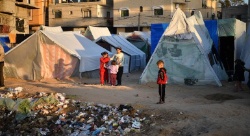Cablegate: Nigeria: West African Gas Pipeline Update
VZCZCXRO3877
PP RUEHMA RUEHPA
DE RUEHUJA #1614 2080655
ZNR UUUUU ZZH
P 270655Z JUL 07
FM AMEMBASSY ABUJA
TO RUEHC/SECSTATE WASHDC PRIORITY 0422
INFO RUEHOS/AMCONSUL LAGOS PRIORITY 7504
RUEHWR/AMEMBASSY WARSAW 0481
RUEHNM/AMEMBASSY NIAMEY 0129
RUEHCO/AMEMBASSY COTONOU 0208
RUEHAR/AMEMBASSY ACCRA 0860
RUEHCD/AMCONSUL CIUDAD JUAREZ 0476
RUEHZK/ECOWAS COLLECTIVE
RUCPDOC/DEPT OF COMMERCE WASHDC
RUEATRS/DEPT OF TREASURY WASHDC
RHEBAAA/DEPT OF ENERGY WASHINGTON DC
UNCLAS ABUJA 001614
SIPDIS
SENSITIVE
SIPDIS
DEPARTMENT PASS TO USTR (AGAMA)
DEPT OF TREASURY FOR DPETERS
DEPT OF COMMERCE FOR 3317/ITA/OA/KBURRESS
DEPT OF ENERGY FOR CAROLINE GAY
E.O. 12598: N/A
TAGS: ENRG ECON EINV EAID NI
SUBJECT: NIGERIA: WEST AFRICAN GAS PIPELINE UPDATE
REF: A. ABUJA 1607
B. ABUJA 1582
C. ABUJA 1575
D. LAGOS 494
E. ABUJA 1376
1. (SBU) SUMMARY: The World Bank-assisted West African Gas
Pipeline (WAGP) project was nearing completion, but faced several
lingering impediments, according to Senior World Bank (WB) Energy
Specialist Waqar Haider. The pipeline would not be commissioned
until June 2008 at the earliest. Pipeline operators continued to
address physical security issues, environmental degradation, and
especially securing reliable gas supplies for export given Nigeria's
looming domestic energy crisis. END SUMMARY.
2. (SBU) On July 16, U.S. Department of Energy International
Affairs Specialist Carolyn Gay met with World Bank (WB) Senior
Energy Specialist Waqar Haider to discuss recent progress on the
WB-sponsored West African Gas Pipeline (WAGP). The WB's involvement
in the WAGP project involved only a partial guarantee, with the
majority of funding coming from international oil companies (IOCs).
Haider indicated WAGP construction was progressing, but the project
would not be commissioned until June 2008 at the earliest.
-----------------
Pipeline Problems
-----------------
3. (SBU) While the offshore segments of the WAGP had been
completed, the onshore segments, as well as metering infrastructure,
were still under construction. Furthermore, a ship anchored off the
coast of Benin in April ruptured an offshore portion of the
pipeline. To cut costs that pipeline area was exposed on the
shallow sea and had not yet been added to nautical charts. Repairs
on the ruptured segment were underway. Adding the offshore pipeline
to nautical charts could avoid pipeline ruptures from ship traffic,
but would also make it accessible to potential saboteurs, said
Haider.
4. (SBU) The pipeline construction had led to environmental
concerns including claims by local fishermen in the Badagri area of
Nigeria that construction reduced their catch. In Ghana, a wall was
constructed to support a portion of the pipeline passing through a
coastline rock structure, leading to coastline erosion.
-----------------
Where is the Gas?
-----------------
5. (SBU) The WAGP received soft commitments from IOCs for feedstock
gas, and confirmed that gas destined for the project would be drawn
from currently-flared and future incremental supplies. However, the
Escravos-Lagos Pipeline (ELP), a main supply line to which the WAGP
would be connected, had been offline since February 2006. The
project might run into supply problems if the Nigerian government
pressured IOCs, who owned the majority shareholding of the WAGP, to
commit gas supplies for the heavily-subsidized domestic market.
IOCs might drag their feet in developing new gas supplies if the GON
did not provide sufficient gas pricing incentives, possibly
curtailing potential supplies designated for the WAGP.
GRIBBIN


 UN News: 10,000 People Feared Buried Under The Rubble In Gaza
UN News: 10,000 People Feared Buried Under The Rubble In Gaza Save The Children: Heat-stricken Bangladesh Extends School Closures
Save The Children: Heat-stricken Bangladesh Extends School Closures Hayden Stephens and Associates: Record Class Action Settlement Gives Hope To 50,000 Australian Junior Doctors
Hayden Stephens and Associates: Record Class Action Settlement Gives Hope To 50,000 Australian Junior Doctors UN News: Healing Page By Page In Earthquake-affected Türkiye
UN News: Healing Page By Page In Earthquake-affected Türkiye Save The Children: Rate Of Attacks On Healthcare in Gaza Higher Than In Any Other Conflict Since 2018
Save The Children: Rate Of Attacks On Healthcare in Gaza Higher Than In Any Other Conflict Since 2018 UN News: Green Light For New Cholera Vaccine, Ukraine Attacks Condemned, Action Against Racism
UN News: Green Light For New Cholera Vaccine, Ukraine Attacks Condemned, Action Against Racism